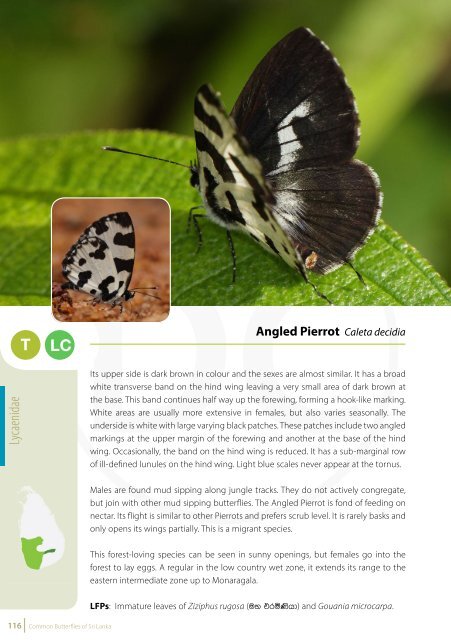Common Butterflies of Sri Lanka
Common Butterflies of Sri Lanka
Common Butterflies of Sri Lanka
You also want an ePaper? Increase the reach of your titles
YUMPU automatically turns print PDFs into web optimized ePapers that Google loves.
T<br />
LC<br />
Angled Pierrot Caleta decidia<br />
Grass Jewel Freyeria putli<br />
T<br />
LC<br />
Lycaenidae<br />
Its upper side is dark brown in colour and the sexes are almost similar. It has a broad<br />
white transverse band on the hind wing leaving a very small area <strong>of</strong> dark brown at<br />
the base. This band continues half way up the forewing, forming a hook-like marking.<br />
White areas are usually more extensive in females, but also varies seasonally. The<br />
underside is white with large varying black patches. These patches include two angled<br />
markings at the upper margin <strong>of</strong> the forewing and another at the base <strong>of</strong> the hind<br />
wing. Occasionally, the band on the hind wing is reduced. It has a sub-marginal row<br />
<strong>of</strong> ill-defined lunules on the hind wing. Light blue scales never appear at the tornus.<br />
Males are found mud sipping along jungle tracks. They do not actively congregate,<br />
but join with other mud sipping butterflies. The Angled Pierrot is fond <strong>of</strong> feeding on<br />
nectar. Its flight is similar to other Pierrots and prefers scrub level. It is rarely basks and<br />
only opens its wings partially. This is a migrant species.<br />
This forest-loving species can be seen in sunny openings, but females go into the<br />
forest to lay eggs. A regular in the low country wet zone, it extends its range to the<br />
eastern intermediate zone up to Monaragala.<br />
It has no minute tail. The female is slightly larger than the male. The upper side is<br />
dark brown throughout with a sub-marginal row <strong>of</strong> circular black spots. In the female,<br />
these spots are faintly bordered in yellowish orange. The prominence <strong>of</strong> markings on<br />
its underside varies. Its most distinct feature is the row <strong>of</strong> circular black spots along the<br />
sub-margin <strong>of</strong> hind wing. These spots are ringed in orange and the amount <strong>of</strong> blue<br />
scales within them varies. Sometimes, these blue scales have a silvery appearance.<br />
Two bands <strong>of</strong> cresecent-shaped markings replace the sub-margin on the forewing.<br />
Both its wings have distal bands and cell end patches consisting <strong>of</strong> paired thin white<br />
streaks. The hind wing has five black spots ringed in white. Sometimes the one at<br />
lower margin is absent.<br />
The Grass Jewel flies amongst very short grasses and herbs. It is very difficult to locate<br />
due to its fluttering flight and small size. It is fond <strong>of</strong> the sun and even flies in the<br />
hottest hours <strong>of</strong> the day. It feeds on the nectar <strong>of</strong> low-lying plants.<br />
This butterfly is found in very thin, low-lying vegetation in the dry zone. These types <strong>of</strong><br />
vegetation are more abundant in arid areas. It is plentiful in its habitats.<br />
Male<br />
Lycaenidae<br />
LFPs: Immature leaves <strong>of</strong> Ziziphus rugosa (uy trñKshd) and Gouania microcarpa.<br />
LFPs: Indig<strong>of</strong>era tinctoria (ks,a wjß), I. linnaei (ìx wjß), I. oblongifolia.<br />
116 <strong>Common</strong> <strong>Butterflies</strong> <strong>of</strong> <strong>Sri</strong> <strong>Lanka</strong><br />
<strong>Common</strong> <strong>Butterflies</strong> <strong>of</strong> <strong>Sri</strong> <strong>Lanka</strong> 117















